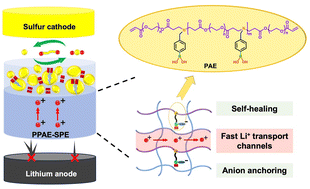All-solid-state lithium–sulfur batteries (ASSLSBs) using poly(ethylene oxide) (PEO) electrolytes offer significant advantages in energy density and safety. However, their development is hampered by the slow Li+ conduction in solid polymer electrolytes and sluggish electrochemical conversion at the cathode–electrolyte interface. Herein, we fabricate a self-healing poly(β-amino ester) with a comb-like topological structure and multiple functional groups, synthesized through a Michael addition strategy. This material modifies the PEO-based solid-state electrolyte, creating fast Li+ transport channels and improving polysulfides conversion kinetics at the electrode surface. Consequently, both modified all-solid-state lithium symmetric cells and lithium–sulfur batteries exhibit improved electrochemical performance. This work demonstrates an expanded interpenetrating macromolecular engineering approach to develop highly ion-conductive solid polymer electrolytes for ASSLSBs.
